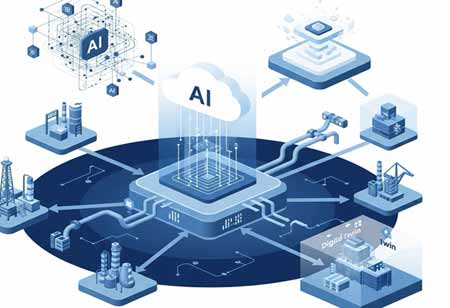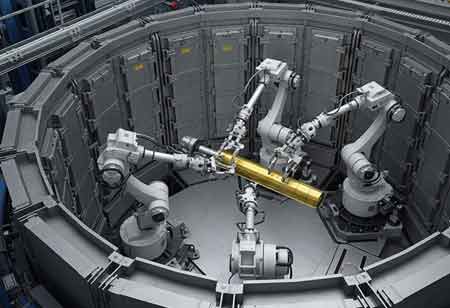CLOSE
Specials
I agree We use cookies on this website to enhance your user experience. By clicking any link on this page you are giving your consent for us to set cookies. More info
Be first to read the latest tech news, Industry Leader's Insights, and CIO interviews of medium and large enterprises exclusively from Energy Tech Review
Thank you for Subscribing
Driving Operational Excellence in European Oil & Gas
The European oil and gas sector is transforming through integrated modelling and digitalisation, enhancing efficiency, safety, and decision-making with advanced technologies and real-time data.

By
Energy Tech Review | Monday, October 13, 2025
Stay ahead of the industry with exclusive feature stories on the top companies, expert insights and the latest news delivered straight to your inbox. Subscribe today.
The European oil and gas sector is undergoing a significant transformation as integrated modelling and digitalisation platforms fundamentally reshape operations across the entire value chain. The focus is on leveraging advanced technologies to enhance efficiency, optimise resource recovery, ensure operational safety, and improve decision-making in an increasingly complex and data-rich environment. This transformation promises a future where the European oil and gas sector operates more efficiently and safely than ever before.
The Foundation: Integrated Modelling and Data Analytics
At the heart of this transformation is the concept of integrated modelling, which involves creating comprehensive digital representations of physical assets and processes. These models surpass traditional simulations by integrating real-time data from sensors, IoT devices, and historical records to power digital platforms with a previously unattainable, holistic view of operations. For instance, in reservoir management, advanced data analytics and modelling techniques are increasingly harnessed to enhance the understanding of reservoir behaviour. This leads to more precise forecasting of future production rates and optimisation of recovery strategies, particularly important for mature fields in Europe. Integrated Asset Modelling (IAM) plays a key role in this process, unifying subsurface reservoir models with surface network and facility models to provide a comprehensive view of the entire production system. This unification fosters a collaborative methodology, moving away from disconnected teams and enabling a holistic management approach.
The digital oilfield concept is a prime example of this integration, where sensors and smart systems are deployed across wells, pipelines, and processing facilities. These interconnected devices generate vast amounts of data, which are then processed and analysed by sophisticated algorithms. This real-time data collection and analysis capability is crucial for optimising production, predicting equipment failures, and enhancing overall operational performance. The European market for digital oilfield technologies has experienced significant growth, reflecting a continued emphasis on improving operational efficiency and reducing production costs across the region. The seamless flow of real-time data enables immediate adjustments to equipment settings, well pressure, and flow rates, ensuring that operations are always efficient and safe. This also helps identify bottlenecks early, improves uptime, and prevents costly delays.
A key enabler of these integrated platforms is the proliferation of advanced analytical capabilities that extract deeper insights from diverse data sources such as seismic surveys, well logs, and production data. This data-driven approach facilitates improved decision-making, allowing for more accurate well placement, optimised drilling processes, and proactive maintenance interventions. The ability to monitor, supervise, and control assets remotely is a direct outcome of these advancements, leading to reduced reliance on on-site personnel and improved operational flexibility. Advanced analytics offer a deeper understanding of operational performance, enabling the identification of areas for cost reduction, enhanced operational efficiency, and improved safety through real-time insights into potential hazards.
Driving Innovation: AI, ML, and Digital Twins
AI and ML are becoming indispensable to integrated platforms in the oil and gas industry, enhancing processes across the entire value chain—from exploration and production to emissions monitoring. AI algorithms can analyse massive volumes of geological and operational data to identify new reserves and optimise drilling parameters. In asset management, AI-powered solutions are crucial for predictive maintenance, enabling the anticipation of equipment failures before they occur. This not only minimises costly downtime but also extends the lifespan of critical infrastructure. ML models also contribute to enhancing production rates by identifying patterns and trends in data, leading to more efficient operations. The integration of AI for continuous emissions monitoring and leak detection is also gaining traction, helping companies meet environmental regulations and reduce their carbon footprint. AI-driven solutions are also optimising logistics and improving the accuracy of demand forecasting within the supply chain. The potential of AI and ML to optimise operations reassures the audience about the industry's efficiency.
The emergence of digital twin technology is further remodelling integrated modelling. A digital twin is a virtual replica of a physical asset, system, or process that is continuously updated with real-time data. This representation enables advanced simulations, predictive analysis, and 'what-if' scenarios, providing operators with unparalleled insights into asset performance and behaviour. In upstream operations, digital twins can simulate drilling processes, incorporating geological data and equipment performance to identify optimal drilling strategies and minimise non-productive time. For midstream operations, digital twins are crucial for monitoring pipeline integrity, predicting potential leaks, and optimising flow. In refineries, they replicate complex processes, enabling fine-tuning to enhance energy efficiency and reduce emissions. This technology significantly enhances decision-making by providing accurate, real-time data and advanced simulations, leading to improved safety, cost savings through proactive maintenance, and increased reliability.
Enabling Progress: Cloud Solutions and Midstream Digitalisation
Cloud computing provides the necessary scalability, flexibility, and processing power to handle the immense datasets generated by modern oil and gas operations. This enables seamless data flow, facilitates collaboration across different functions, and simplifies the integration of new digital services. The adoption of cloud technologies enables the remote management of workforces and the real-time monitoring of processes and equipment, significantly enhancing operational agility and responsiveness. Cloud platforms offer elastic resource allocation, which is particularly beneficial for running intensive simulations during peak periods, such as exploration campaigns or large-scale production planning. Cloud-based collaborative modelling tools also enable teams from different locations to work together in real-time, integrating various data sources and refining models more efficiently.
The European oil and gas midstream sector is undergoing significant digitalisation, with integrated platforms enabling remote surveillance, subsea monitoring, and pipeline inspection. Advanced analytics and data management simplify complex trade data, providing actionable insights and facilitating regulatory compliance. Solutions for pipeline integrity and leak detection are becoming more sophisticated, incorporating real-time sensor data and predictive analytics to identify vulnerabilities and schedule timely interventions. This digitalisation improves efficiency, reduces operational risks, and enhances the overall security of transportation networks.
The future of these platforms in Europe is heading toward a highly integrated and intelligent ecosystem, where interconnected digital technologies collectively drive operational excellence. The focus will continue to be on leveraging data-driven insights to optimise production further, enhance safety protocols, and improve environmental performance. This continuous evolution promises to unlock new levels of performance and sustainability across the entire value chain.

Copyright © 2025 Energy Tech Review. All rights reserved






